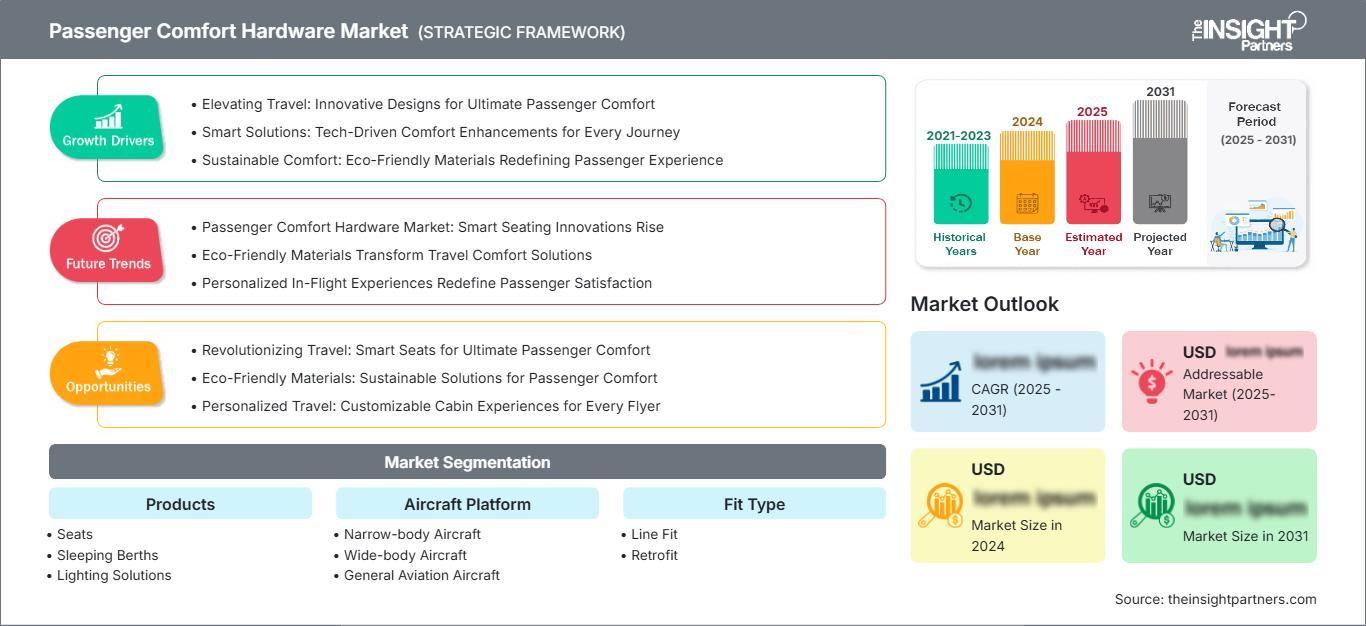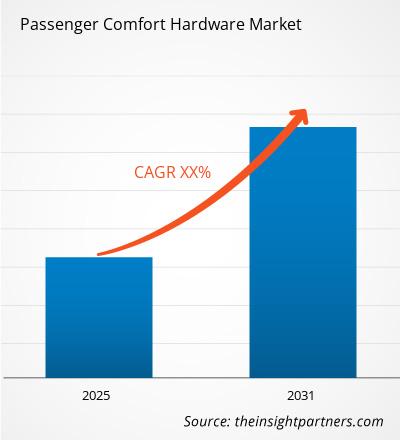Le marché des équipements de confort pour passagers devrait connaître une croissance soutenue de 2026 à 2034, sa valeur étant estimée à un niveau supérieur à celui de 2025 et poursuivant son expansion jusqu'à la fin de la période de prévision. Cette tendance reflète des perspectives de marché favorables, portées par l'évolution des besoins du secteur et les progrès technologiques constants.
Le rapport est structuré par produits (sièges, couchettes, solutions d'éclairage) et analyse le marché en fonction de la plateforme aéronautique (avions monocouloirs, avions gros-porteurs, avions d'aviation générale). Il examine également le marché par type d'installation (installation d'origine, modernisation). Une analyse détaillée est fournie aux niveaux mondial, régional et national pour chacun de ces segments clés.
Le rapport inclut la taille du marché et les prévisions pour tous les segments, exprimées en dollars américains. Il présente également des statistiques clés sur la position actuelle des principaux acteurs du marché, ainsi que des informations sur les tendances actuelles et les opportunités émergentes.
Objectif du rapport
Le rapport « Marché des équipements de confort des passagers » de The Insight Partners vise à décrire le contexte actuel et la croissance future, les principaux facteurs de croissance, les défis et les opportunités. Il fournira des informations précieuses à divers acteurs du secteur, tels que :
- Fournisseurs de technologies/Fabricants : Pour comprendre l’évolution de la dynamique du marché et connaître les opportunités de croissance potentielles, afin de prendre des décisions stratégiques éclairées.
- Investisseurs : Réaliser une analyse complète des tendances concernant le taux de croissance du marché, les projections financières du marché et les opportunités existantes tout au long de la chaîne de valeur.
- Organismes de réglementation : Réglementer les politiques et les activités de police sur le marché afin de minimiser les abus, de préserver la confiance des investisseurs et de maintenir l’intégrité et la stabilité du marché.
Produits de segmentation du marché des équipements de confort des passagers
- Sièges
- Couchettes
- Solutions d'éclairage
Plateforme aéronautique
- Avions à fuselage étroit
- Avions gros-porteurs
- Avions d'aviation générale
Type de coupe
- Ajustement en ligne
- Rénovation
Vous bénéficierez d'une personnalisation gratuite de tous les rapports, y compris certaines parties de ce rapport, l'analyse par pays, le pack de données Excel, et vous profiterez également d'offres et de réductions exceptionnelles pour les start-ups et les universités.
Marché des équipements de confort des passagers : Perspectives stratégiques

-
Découvrez les principales tendances du marché présentées dans ce rapport.Cet échantillon GRATUIT comprendra une analyse de données, allant des tendances du marché aux estimations et prévisions.
Facteurs de croissance du marché des équipements de confort des passagers
- Voyager autrement : des conceptions innovantes pour un confort optimal des passagers
- Solutions intelligentes : des améliorations de confort technologiques pour chaque voyage
- Confort durable : des matériaux écologiques redéfinissent l'expérience des passagers
Tendances futures du marché des équipements de confort des passagers
- Marché des équipements de confort pour passagers : l’essor des innovations en matière de sièges intelligents
- Les matériaux écologiques transforment les solutions de confort de voyage
- Des expériences personnalisées en vol redéfinissent la satisfaction des passagers
Opportunités du marché des équipements de confort des passagers
- Révolutionner les voyages : des sièges intelligents pour un confort optimal des passagers
- Matériaux écologiques : des solutions durables pour le confort des passagers
- Voyages personnalisés : des expériences en cabine personnalisables pour chaque voyageur
Aperçu régional du marché des équipements de confort des passagers
Les analystes de The Insight Partners ont analysé en détail les tendances régionales et les facteurs influençant le marché des équipements de confort des passagers tout au long de la période prévisionnelle. Cette section aborde également les segments de marché et la répartition géographique du marché en Amérique du Nord, en Europe, en Asie-Pacifique, au Moyen-Orient et en Afrique, ainsi qu'en Amérique du Sud et centrale.
Portée du rapport sur le marché des équipements de confort des passagers
| Attribut du rapport | Détails |
|---|---|
| Taille du marché en 2025 | XX millions de dollars américains |
| Taille du marché d'ici 2034 | XX millions de dollars américains |
| TCAC mondial (2026 - 2034) | XX% |
| Données historiques | 2021-2024 |
| Période de prévision | 2026-2034 |
| Segments couverts |
Sous-produits
|
| Régions et pays couverts |
Amérique du Nord
|
| Leaders du marché et profils d'entreprises clés |
|
Densité des acteurs du marché des équipements de confort des passagers : comprendre son impact sur la dynamique commerciale
Le marché des équipements de confort pour passagers connaît une croissance rapide, portée par une demande croissante des utilisateurs finaux. Cette demande est alimentée par l'évolution des préférences des consommateurs, les progrès technologiques et une meilleure connaissance des avantages de ces produits. Face à cette demande grandissante, les entreprises élargissent leur offre, innovent pour répondre aux besoins des consommateurs et tirent parti des tendances émergentes, ce qui contribue à stimuler la croissance du marché.

- Découvrez un aperçu des principaux acteurs du marché des équipements de confort passager.
Points clés de vente
- Couverture exhaustive : Le rapport couvre de manière exhaustive l’analyse des produits, services, types et utilisateurs finaux du marché des équipements de confort des passagers, offrant ainsi une vue d’ensemble.
- Analyse d'experts : Ce rapport est établi sur la base d'une compréhension approfondie des experts et analystes du secteur.
- Informations à jour : Ce rapport garantit sa pertinence commerciale grâce à sa couverture des informations et tendances récentes en matière de données.
- Options de personnalisation : Ce rapport peut être personnalisé pour répondre aux exigences spécifiques du client et s’adapter parfaitement aux stratégies commerciales.
Le rapport d'étude de marché sur les équipements de confort des passagers peut donc contribuer à décrypter et à comprendre le contexte sectoriel et les perspectives de croissance. Malgré quelques points à améliorer, les avantages de ce rapport l'emportent généralement sur les inconvénients.
- Analyse historique (2 ans), année de base, prévision (7 ans) avec TCAC
- Analyse PEST et SWOT
- Taille du marché Valeur / Volume - Mondial, Régional, Pays
- Industrie et paysage concurrentiel
- Ensemble de données Excel
Rapports récents
Témoignages
Raison d'acheter
- Prise de décision éclairée
- Compréhension de la dynamique du marché
- Analyse concurrentielle
- Connaissances clients
- Prévisions de marché
- Atténuation des risques
- Planification stratégique
- Justification des investissements
- Identification des marchés émergents
- Amélioration des stratégies marketing
- Amélioration de l'efficacité opérationnelle
- Alignement sur les tendances réglementaires






















 Obtenez un échantillon gratuit pour - Marché du matériel de confort des passagers
Obtenez un échantillon gratuit pour - Marché du matériel de confort des passagers